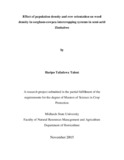Please use this identifier to cite or link to this item:
https://cris.library.msu.ac.zw//handle/11408/2120| Title: | Effect of population density and row orientation on weed density in sorghum-cowpea intercropping systems in semi-arid Zimbabwe | Authors: | Haripo, Tafadzwa Talent | Keywords: | Intercropping, intercrop population, row orientation Weed frequency, weed density |
Issue Date: | Nov-2015 | Publisher: | Midlands State University | Abstract: | Sorghum plant densities in semi-arid areas are generally lower than in wetter environments leaving lots of bare ground which promotes weeds. Intercropping using the optimum plant density of the minor crop and the most effective row orientation for weed control in these areas is one important step in integrated weed control management (IWM). Information on the cowpea population density and row orientation effects on weed density, growth and yields of sorghum-cowpea cropping systems is however scanty or unavailable for tropical Africa. This study was carried out to assess farmers’ perceptions on intercropping and to determine the effects of population density and row orientation on weed density and yield of sorghum-cowpea intercropping systems in semi-arid Zimbabwe. The research consisted of a survey and a field experiment. The survey was conducted in Ward 15 and Ward 25 of Matobo district. A multistage sampling technique was used to select the sampling units for the interview. Matobo district was purposively selected since the on-station trials were conducted within this district. The two wards (Ward 15 and 25) were also purposively selected and two villages from each ward were randomly selected. The villages were Mkhokha and Nyumbani in Ward 15 and Foxfarm and Phakama in Ward 25. Within each village, 15 households were randomly selected to get a total of 60 households. Snowballing approach was used to identify farmers practising intercropping. The questionnaires were randomly administered to the selected households. The results showed that adoption of intercropping by the farmers was 60.0 % and 46.7 % for Ward 15 and 25 respectively. Some of the farmers who practised intercropping were using the old paradigms which generally result in soil resource exploitation thereby making sustainable land use impossible socially, ecologically and economically. Farmers in Matobo do not use scientifically proven intercropping methods. The field experiment was carried out at Matopos Research Station which is located in Natural Region IV. The experiment was laid in a 2 x 7 factorial arrangement of a Randomised Complete Block Design with three replications. The treatments consisted of sorghum planted at a constant population of 55 556 plants/ha (90 x 20 cm) intercropped with cowpea at varying populations of 111 111 plants/ha (45 x 20 cm), 166 667 plants/ha (30 x 20 cm) and 222 222 plants/ha (22.5 x 20 cm) in East-West (E-W) and North-South (N-S) row orientation with the main crop and the intercrops being planted simultaneously in the plots.The results revealed that at 3 weeks after crop emergency (3WACE) prior to first weeding, the interaction of population density and row orientation and individual factors did not significantly affect the weed density or number of weeds per m2. The weed species which were more prevalent were Tagetis minuta, Schkuria pinnata, Cyperus tridens and Cyperus rotundus. Weed density was significantly affected by the interaction of cowpea population density and row orientation at 6 weeks after crop emergency (6WACE). The weed density was higher in the treatments with combination of sole crops at lower population density and EW row orientation compared to the treatments combination which had intercropped crops at higher population density and NS row orientation. Mean comparisons showed that the lowest weed density was 10 plants/m2 and was obtained by a combination of the highest cowpea intercrop population of 222 222 plants per hectare and NS row orientation which produced the best results in supressing weeds. The highest weed density of 48 plants/m2 was obtained in the treatment with sole sorghum and EW row orientation. There was no interaction between cowpea population density and row orientation in determining density of C. rotundus. Effects of individual factors were not significant in determining the density of C. rotundus. The interaction of cowpea population density and row orientation significantly (P<0.05) influenced density of S. pinnata and T. minuta and C. tridens. Lower cowpea population density of 111 111 plants/ha in EW row orientation had the least effects in weed suppression while the highest cowpea density of 222 222 plants/ha in both NS and EW row orientation had the greatest effects in weed suppression. From these results, it can be concluded that 222 222 plants/ha (highest cowpea population density) and both NS and EW row orientation were more effective in controlling some weed species. A LER which is above a unit for both EW and NS row orientation and population densities ranging from 111 111 to 166 667 plant/ha was obtained. The LER for the cowpea intercrop population of 222 222 plant/ha in both EW and NS was less than a unit to show that intercropping was not advantageous. Farmers in Matobo district should plant sorghum-cowpea intercrops in EW row orientation for increased cowpea grain yield but NS row orientation for sole sorghum | URI: | http://hdl.handle.net/11408/2120 |
| Appears in Collections: | Masters Of Science In Crop Protection |
Files in This Item:
| File | Description | Size | Format | |
|---|---|---|---|---|
| Haripo Final Project OG.pdf | Full Text | 1.68 MB | Adobe PDF |  View/Open |
Page view(s)
114
checked on Jan 15, 2025
Download(s)
82
checked on Jan 15, 2025
Google ScholarTM
Check
Items in MSUIR are protected by copyright, with all rights reserved, unless otherwise indicated.


